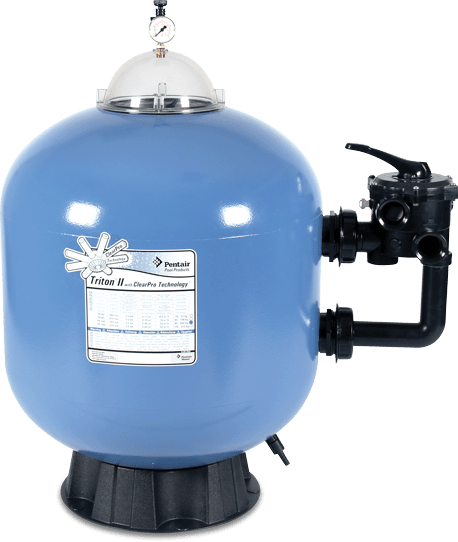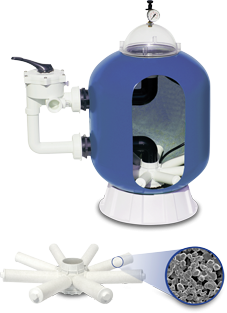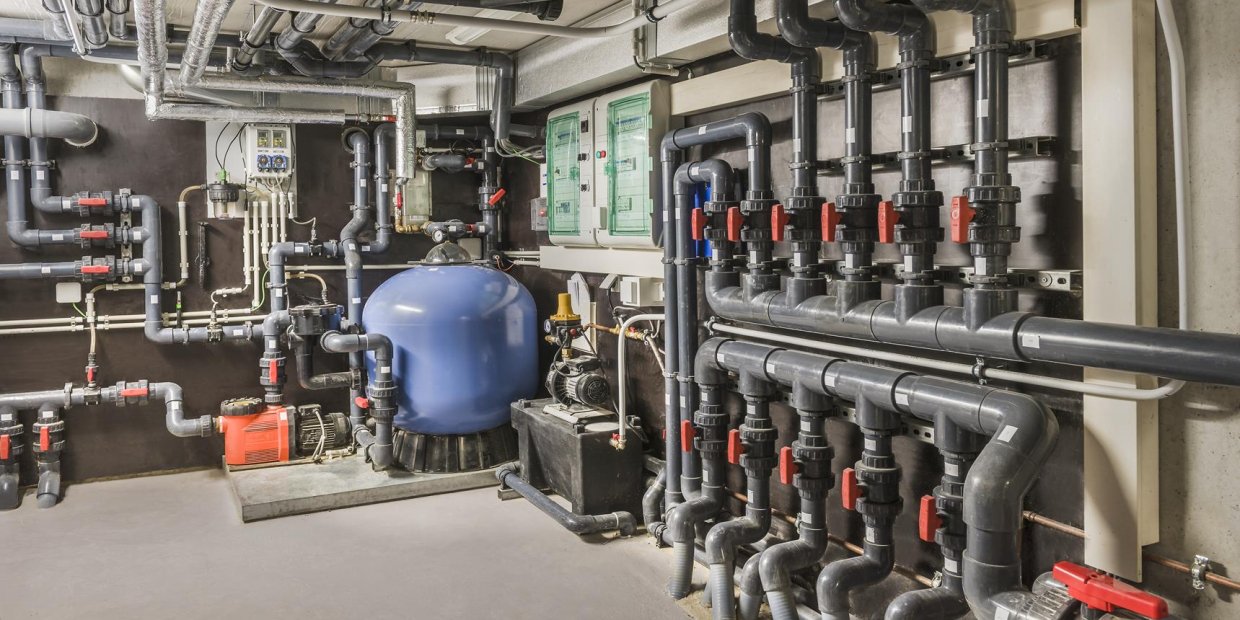The filter system is a very important part of your swimming pool. Choosing the right filter takes time and effort. As a swimming pool builder with years of experience, we always go for Triton sand filters by Pentair. These pool filters have consistently proven their quality and reliability and, what’s more, they are extremely durable.
Benefits of a sand filter
The pool sand filter is a high-quality filter system. Unlike other filter systems, this type of filter catches both the large and small dirt particles. The large particles include debris such as hair, insects and leaves. Most filters catch this larger debris quite well.
The difference lies in the smaller dirt particles, the real swimming pool polluters. This category includes algae and phosphates. A sand filter is the only way to remove the invisible little contaminants from your swimming pool.
By choosing a Triton sand filter by Pentair, you can reduce the algal growth significantly.


Operation of the sand filter
A sand filter won’t work if you do not have a swimming pool pump; you need both system components to make sure your pool water becomes crystal clear again.
The swimming pool pump pumps the water from the pool to the swimming pool filter. The pool water goes through the skimmers, the overflow or the underflow to the sand filter. This is the surface water. The pump also brings the water to the sand filter via the pool vacuum cleaner.
If you have a skimmer pool, then the skimmer system will most likely have a pre-filter or filter basket. This can already collect the first larger debris. You should definitely also use the Net’Skim pre-filter collection bags to catch all bigger debris (twigs, leaves, insects, etc.) so that it doesn’t reach the sand filter, prolonging the filter’s lifespan.
Once the water gets to the pool sand filter, it is pumped through the sand filter from top to bottom. This filter is filled with a filtration medium. We always choose sand, despite the availability of other media, for example glass pearls.
The water rests on top of the sand and seeps down through it. The dirt particles stick to the sand and fresh clear water comes out of the pool filter. The water is then guided back to the swimming pool, sometimes passing a pool heating system first.
Selecting the right sand filter depends on the volume of your swimming pool. You should test this volume against the flow rate of your sand filter. For a private pool, you should choose a filter that can filter all the water in your pool within 6 hours.
| Flow | 8.5 m³/h | 14 m³/h | 22 m³/h |
|---|---|---|---|
| Max. pool volume | 50m³ | 80 m³ | 130 m³ |
| Filter media | 50 kg of filter sand and 25 kg of filter gravel | 100 kg of filter sand and 50 kg of filter gravel | 200 kg of filter sand and 100 kg of filter gravel |
Obviously a filter only works with the right filter material. You can order both filter sand and filter gravel here in bags of 25 kg.
Below is a diagram for the filter sand of Pentair pool filters.
| Type of filter | Filter sand | Filter gravel (coarse) |
|---|---|---|
| Triton TR 40 | 50 kg | 25 kg |
| Triton TR 60 | 75 kg | 50kg |
| Triton TR 100 | 200 kg | 100 kg |
It goes without saying that you should add the filter gravel to the sand filter first. Then you add the filter sand. This way you get the best possible filtering with this sand filter for your swimming pool.

The six settings of the sand filter
The sand filters always have a six-port valve with different settings. We would like to explain what each setting does.
1. Filter: This is what your sand filter does 99% of the time, it filters the swimming pool water.
2. Waste: In this position, the water runs directly out of the filter, bypassing the sand. This is only used when the pool is very dirty and thorough pool cleaning is necessary. Please note: this setting actually empties your pool.
3. Backwash: This is a short cleaning cycle of the sand to improve filtration (see ‘Maintenance of your swimming pool filter’). It is recommended to do this once a week. The water is washed back through the sand in reverse order (from bottom to top), removing the dirt from the filter material.
4. Rinse: This setting is used directly after backwashing. Allow the water to run through the filter from top to bottom for 30 seconds while the water is drained into the sewer system. This ensures all the sand is put back in place and that any remaining dirt is drained away, as in the ‘waste’ position.
5. Circulation: The water runs from the pump directly back to the swimming pool without going through the pool filter. This means the water isn’t filtered.
6. Closed: All ports are closed. If your pump is still on, make sure to switch it off within seconds as the pressure builds up incredibly fast! This setting is generally used when servicing the pump. This way no water can come back to the pump from the sand filter when you switch off the pump for a while.
Maintenance of your swimming pool filter
A swimming pool filter generally needs very little maintenance. You should clean the filter every week by performing a backwash for about 5 minutes. Then set the filter to ‘Rinse’ to quickly wash away any dirt.
After 5 years you will need to replace the sand in your filter. By then the top layer of the sand is more difficult to penetrate because of accumulated matter. The sand filter can therefore become clogged, increasing the pressure inside the filter and reducing the filter’s flow rate. Not replacing the sand may result in your filter breaking down completely.









